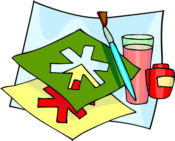The first day of Passover, this year on the Jewish Lunar Calendar, is April 9th, 2009. Matzoh is the traditional unleavened bread that is eaten during Passover, which dates back to when the Hebrew Slaves were free to leave Egypt. According to the legend, the Hebrew Women did not have time to bake the bread in the oven and the sun baked the dough on their backs. It turned out flat, but tasty. It is called Matzoh and available in the supermarket in the Kosher Food Aisle. There are many tasty recipes made from Matzoh or Matzoh Meal such as:
Benji’s Family Cookbook for Jewish Holidays
Easy Matzah Balls
What you Need:
2 Tbs. oil
2 eggs, slightly beaten
1/2 cup matzah meal
1 tsp. salt
1 Tbsp. water or chicken soup
1. Mix oil and eggs together in a bowl.
2. Add matzah meal and salt. Mix well. Add water and mix again.
3. Cover with plastic wrap and refrigerate for 1/2 hour.
4. Fill a large pot half full with water and bring to a boil.
5. Wet your hands and take about a tablespoon of mixture and roll into a ball. Drop into boiling water. Reduce heat to a slow boil. Cook covered for 30-40 minutes.
6. Remove from water and serve with chicken soup.
Makes 10-12 servings
*This recipe is from MATZAH MEALS, “A Passover Cookbook for Kids,” by Judy Tabs and Barbara Steinberg. Illustrated by Chari R. McLean.
Traditional Passover Foods & Their Symbolism
Courtesy of Fabulous Foods
Unleavened Bread — In their haste to leave Egypt and escape slavery, the Isrealites had no time to let dough rise for bread. Their only provision was matzoh, which is made of wheat but not allowed to ferment or rise. Matzoh is a perfect example of how the food we eat is intricately woven into history, traditions and culture. It is the bread of both slavery and of freedom.
Roasted Lamb Bone — The roasted lamb bone symbolizes the lamb that was sacrificed at the Holy Temple of Jerusalem on the eve of the exodus of the Israelites from Egypt. The blood of that ancient sacrifice was used to mark the doors of the Israelites, so they might be “passed over.” Today, many families substitute a chicken or turkey neck for the lamb. Whichever meat you choose, roast it in the oven until done, then scorch over a flame, like a gas burner or grill. Jewish vegetarians have been known to use a whole roasted beet instead of lamb.
Roasted Egg — Eggs symbolize the perpetual cycle of life, from birth to death to re-birth. To roast eggs, first hard boil them, then, using tongs, hold over a gas burner or candle flame.
Bitter Herbs — Fresh horseradish, without beets or vinegar, graces the Seder plate to symbolize the bitterness of slavery.
Greens — Greens, usually fresh parsley or celery tops, represent re-birth and spring.
Salt Water — The greens are traditionally dipped in salt water, which symbolizes the tears of the Hebrew slaves.
Charoset — A traditional Passover dish, charoset consists of a mixture of chopped fruits, usually apples, nuts, raisins, spices and wine. The mixture represents the mortar Hebrew slaves used to make bricks for the Pharaoh Ramses II.
Lamb Crafts
Cottony lambs
Supplies:
Black construction Paper
Cotton Balls
White Chalk
Have the child trace their hands on the black paper. Cut these out, placing the “hands” upside down so that the four fingers are the legs and the thumb is the head. Have the kids glue cotton balls to the “body”. Use chalk or construction paper or whatever to make the eyes.
Lambs
Supplies:
White Paper
Black Paint
Glue
Packing Popcorn, etc.
Use black paint on the hands and stamp them on a white piece of paper, then decorate. The lambs look cute with packing “popcorn” or white paper reinforcements make great “wool”. Also, left-over batting or stuffing can be used.
Afikomen Matzoh Cover
Craft submitted by Ellen G. Berozofsky
(The Afikomen is a piece of matzoh that gets hidden during the Seder. The child who finds it gets a prize. Sometimes a dollar or a small gift.)
Supplies needed:
1 sheet royal blue felt (9 x 12)
1 sheet White felt (9 x 12)
gold or silver glitter glue
bottle of tacky glue
stencil letters
white lace
Simply glue the two sheets together around the edges (leaving one side open for a piece of matzoh). Use the stencil letters to trace the letters: AFIKOMEN Color the letters in with colored glitter glue. Add lace if you wish to the outside and sequins (optional).
Use the Afikomen cover for your Passover Seder (Special Passover Meal).
First Seder is Wednesday, April 19, 2000
Second Seder is Thursday, April 20, 2000
Passover Links to Other Sites
Three Passover Recipes
Passover Webcards
Kids Domain Passover Pages
Torah Tots


